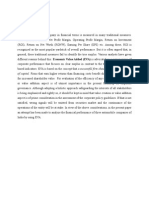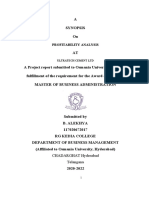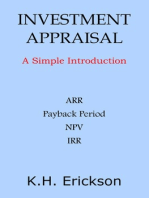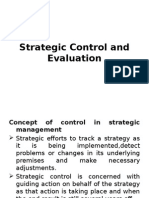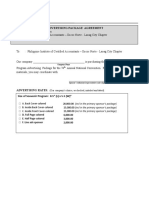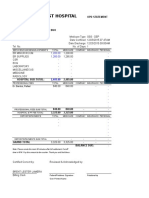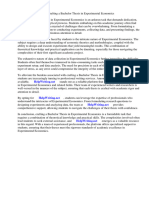Irala (2017) - EVA
Irala (2017) - EVA
Uploaded by
SyefirabellaCopyright:
Available Formats
Irala (2017) - EVA
Irala (2017) - EVA
Uploaded by
SyefirabellaCopyright
Available Formats
Share this document
Did you find this document useful?
Is this content inappropriate?
Copyright:
Available Formats
Irala (2017) - EVA
Irala (2017) - EVA
Uploaded by
SyefirabellaCopyright:
Available Formats
Corporate Performance Measures in India: An Empirical Analysis WP-2007/01/A
Corporate Performance Measures in India:
An Empirical Analysis
Lokanandha Reddy Irala1
Abstract
Traditionally periodic corporate performance is most often measured using some
variant of historical accounting income (eg. Net Profit, EPS) or some measures
based on the accounting income (eg. ROI / ROCE). However it had long been
recognized that accounting income is not a consistent predictor of firm value
creation and the traditional measures are not appropriate for evaluation of
corporate performance
An appropriate measure of corporate performance on one hand should be highly
correlated to share holder return and on the other hand should be able to signal
the extent of periodic wealth creation. A search for such a measure had been the
trigger for the rapidly growing literature on value based management (VBM).
Among the set of popular VBM systems, a variant of the traditional residual
income measure known as Economic Value Added (EVA) is arguably the most
prominent
This paper examines whether Economic Value Added has got a better predictive
power relative to the traditional accounting measures such as EPS, ROCE,
RONW, Capital Productivity (Kp) and Labor Productivity (Lp)
Analysis of 1000 companies across 6 years (6000 company years), very much
supports the claim that the EVA is the better predictor of market value compared
to other accounting measures. EVA is gaining recognition as fundamental
measure of company performance despite the fact that it has been in existence
for a relatively short period of time.
Key Words: EVA, Performance Measures, Market Value
JEL Classification: G00, J33, L21, M40, M52
1. Introduction
For long, there had been wide acceptance on the objective of the firm -to maximize the value.
While the principle that the fundamental objective of the business-corporation is to increase the
value of its shareholders' investment is widely accepted, there is substantially less agreement about
how this is accomplished (Rappaport, 1986)
As the lenders (debt holders & others), can protect themselves contractually, the objective can be
narrowed down to maximizing stockholder value or stockholder wealth. When financial markets are
1
Associate Professor & Director-Administration, Dhruva College of Management, Hyderabad.
He can be reached at reddyirala@gmail.com
Lokanandha Reddy Irala Page 1 of 13
Electronic copy of this paper is available at: http://ssrn.com/abstract=964375
Corporate Performance Measures in India: An empirical Analysis WP-2007/01/A
efficient, the objective of maximizing stockholder wealth can be narrowed even further- to
maximizing stock prices. (Damodaran, 2002)
Even though stock price maximization as an objective is the narrowest of the value maximization
objectives, it is the most prevalent one. It is argued that the stock prices are the most observable of
all measures that can be used to judge the performance of a publicly traded firm. Besides this, the
stock price is a real measure of stockholder wealth, since stockholders can sell their stock and
receive the price now.
Should we accept that the stock price maximization leads to firm value maximization, can we make
managers responsible for the stock price maximization? While the responsibility of firm value
maximization has to be fixed with the managers, using stock prices as a measure of periodic
measure of corporate performance throws a serious problem.
While many argue that the stock prices are not under the full control of the managers, there are
many others who believe that stock price maximization leads to a short term focus for manager-as
the stock prices are determined by traders, short term investors and analysts, all of whom hold the
stock for short periods and spend their time trying to forecast next quarter's earnings
So, traditionally periodic corporate performance is most often measured using some variant of
historical accounting income (eg. Net Profit, EPS) or some measures based on the accounting
income (eg. ROI / ROCE).
However it had long been recognized that accounting income is not a consistent predictor of firm
value creation and the traditional measures are not appropriate for evaluation of corporate
performance
An appropriate measure of corporate performance on one hand should be highly correlated to
share holder return and on the other hand should be able to signal the extent of periodic wealth
creation. A search for such a measure had been the trigger for the rapidly growing literature on
value based management (VBM). Among the set of popular VBM systems, a variant of the
traditional residual income measure known as Economic Value Added (EVA) is arguably the most
prominent
This paper examines whether Economic Value Added has got a better predictive power relative to
the traditional accounting measures such as EPS, ROCE, RONW, FCF, Capital Productivity (Kp)
and labor Productivity (Lp)
2. Traditional Performance Measures: A Critical Evaluation
It is known that the managers maximize firm value by accepting positive NPV investments-
Investments that earn more return than the hurdle rate (cost of capital).
2-1. Profits
Tying compensation to profits has obvious problems. An ambitious manager, expecting a quick
career jump might be tempted to earn more short-term profit- by cutting or postponing expenses on
Research & Development, maintenance, staff training etc –ignoring their long term consequences.
This apart, profit is an absolute measure of performance as it considers neither the cost nor the size
of capital employed to generate the given profit. So two companies can never be directly compared
based on their profits and hence the performance of their managers
Growth in profits does not necessarily mean that shareholders are better off. Any investment with a
positive rate of return (even 2 or 3 percent) will eventually increase earnings. If managers are told
to maximize growth in profits, they might purposefully invest in projects offering 2 or 3 percent rates
of return – projects that destroy value.
Lokanandha Reddy Irala Page 2 of 13
Electronic copy of this paper is available at: http://ssrn.com/abstract=964375
Corporate Performance Measures in India: An Empirical Analysis WP-2007/01/A
Shareholders don’t want growth in profits for its own sake, and they are not content with 2 or 3
percent returns. They want positive NPV investments – they want the company to invest only if the
expected rate of return exceeds the cost of capital (hurdle rate). In some cases the incremental
profits may result from an un economically large increase in investment generating a return that is
not adequate even to cover the cost of capital.
2-2. Earnings per Share (EPS)
EPS is a measurement of company’s per share performance. It is a ratio of net income to the
number of shares out standing.
EPS -when compared to profits - is a relative measure as it considers the size of the capital (in the
form of numbers of share holders). However like profits it doesn’t consider the cost of capital
invested to generate the profits.
EPS as a performance measure might motivate the managers to resort to investment as long as
they generate positive returns – no matter they are much below the hurdle rate.
2-3. Return on Capital Employed (ROCE)
ROCE is the ratio of net operating profit to the net operating assets or capital.
ROCE is an improvement over EPS as it links the returns generated to the capital employed.
However it does not include the cost of such capital employed. For example two investments can’t
be rated as equally good even if they have the same ROCE unless costs of financing these
investments are equal
As a managerial performance measure, ROCE might encourage managers to reject even good
investments (whose expected returns exceed WACC) when such returns are expected to lower the
current Average ROCE.
2-4. Return on Equity (ROE) / Return on Net Worth (RONW)
ROE indicates how much the firm has earned on the funds employed by the shareholders.
ROE like ROCE doesn’t include cost of capital (Equity in this case) in its computation. ROE as a
performance measure might encourage managers to accept investments capable of adding some
earnings even if they don’t cover the cost of capital / earn the required return.
Besides this, ROE is very strongly affected by capital structure changes and hence might not
indicate the operating efficiency of managers
3. Economic Value Added
3-1. What is EVA?
Economic value added (EVA) provides the rupee value created for investors in a given time period
by weighing the profit generated by a decision against the value (cost) of the capital employed to
generate that profit.
EVA is the Adjusted Net Operating Tax After Tax (ANOPAT) for a period minus the capital charge
(the rupee cost of capital) of the investment over that period.
EVA can be expressed as
EVA = Adjusted Net Operating Profit After Taxes (ANOPAT) - Capital Cost
Where
Lokanandha Reddy Irala Page 3 of 13
Corporate Performance Measures in India: An empirical Analysis WP-2007/01/A
ANOPAT2 = Capital Employed (CE) X ROCE (as ROCE = EBIT (1-T) / CE)
Capital Cost = WACC X Capital Employed (CE)
Thus
EVA = Capital Employed (CE) X ROCE - WACC X Capital Employed
EVA = (ROCE - WACC) Capital Employed
Capital is generally measured by book value. WACC is the weighted Average of cost of Equity
(generally measured by CAPM) and cost of Debt.
3-2. EVA and Corporate Performance
If managers are told that the corporate performance is measured by EVA and their compensation is
liked to that, they would try to improve EVA by doing one or more of the following.
A. Improve returns with the existing Capital
Look at the EVA equation. EVA improves if managers earn more returns without
increasing the capital and its cost.
B. Employ Capital productively
EVA also improves when they employ less capital to earn the given returns. This forces
them to productively employ the capital. This will also motivate mangers to return the
excess cash o the shareholders in the absence of positive NPV projects.
C. Reduce the capital cost
The EVA improves when we employ a given level of capital to earn a given level of profit;
if the cost of capital can be reduced. This drives managers to be careful while financing
the investments
When managers do one or more of the above the value of the firm increases. So improving EVA
theoretically improves the value of the firm and hence is a good measure of managerial /corporate
performance
The EVA’s strongest selling point is that it closely tracks increases or declines in market value’. So,
over time, a company that increases decreases its EVA will also increase or decrease its
shareholder wealth
The EVA is thought to have all the characteristics of then appropriate performance measure as it
considers, in its computation;
a. the amount of capital invested
b. the return earned on the capital and
c. cost of capital (WACC) – reflecting the risk adjusted required rate of return
and hence EVA is promoted to be a better measure than the Free Cash Flow(FCF), Profit After
Tax(PAT), Earnings Per Share(EPS), Return on Investment(ROI) and Net Operating Profit After
Taxes(NOPAT) as a periodic measure of shareholder wealth creation
3-3. The Relationship between EVA and Market Value:
2
ANOPAT is derived by adding back to the reported net operating profit the non cash items such as
amortization of goodwill increase in bad debt reserve, increase in capitalized R & D costs etc…. To facilitate
quick understanding, its simplest form is used.
Lokanandha Reddy Irala Page 4 of 13
Corporate Performance Measures in India: An Empirical Analysis WP-2007/01/A
The major attraction with EVA is that it is linked to the value of the firm and hence capable of
signaling the value creation or otherwise of it
It is not too uncommon that the Market Value of a firm (Market value of Debt and Market value of
Equity) either exceeds or falls short of its Book Value. The difference is the Market Value Added
(lost). MVA can be arrived at by discounting back the Future EVAs.
MVA = Future EVAs discounted back
Market Value of the firm = Book Value of the firm + MVA
and with simplifying assumption that market and book value of debt are equal,
Market Value of Equity = Book Value of Equity + Market Value Added
The Market Value of equity exceeds its Book value when the MVA is positive and in this case the
Market Value of the equity is said to be at a premium. On the other hand it will be at a discount
when MVA is negative.
Pic 1 captures the link between Market Value, EVA and MVA
Market EVA 1 EVA 2 EVA 3
Market Value = + + + .......................
(1 + k)1 (1 + k)2 (1 + k)3
Value of Added
Equity Book Value
of Equity
Pic 1a. The relationship between MVA and EVA when the market value of the firm is
more than its book value
Market -EVA 1 -EVA 2 -EVA 3
= + + + .......................
Book Value Lost (1 + k)1 (1 + k)2 (1 + k)3
Value of
Market
Equity
Value of
Equity
Pic 1b. The relationship between MVA and EVA when the market value of the firm is less
than its book value
4. The Current Investigation
There have been many papers (Preinreich,1936; Peasnell, 1981; Peasnell,1982; Egginton, 1984;
Stark, 1986) that presented a clear theoretical link between current market value, current book
value and future residual incomes.
There have been many studies in the US testing the above claims--that the EVA is better than its
accounting counterparts; EVA is linked to the market value of the firm. These studies varied in their
rigor and the results
In the Indian context, there had been numerous papers introducing and advocating EVA (Stern,
2001; Jagannathan, 2004; Lawrence and Smith, 2001; Holden and Davey, 1999; Holden and
Davey, 2000; Arundhathi, 2004; Prasanna, 2001; David, 2002; Mayura, 2004; Mahalingam, 2001;
Venkatesh, 2001),
Lokanandha Reddy Irala Page 5 of 13
Corporate Performance Measures in India: An empirical Analysis WP-2007/01/A
However, there are very few and restrictive studies testing the above claims in India (Bhalla, 2004;
Meenakshi, 2001; Swain, Mishra and Mukesh, 2002;Venkateswarlu and Nitish, 2004; Banerjee,
2000)
Though few Indian Companies joined the band wagon of their American counterparts in adapting
EVA based corporate performance systems, many other are hesitating as there is no strong
evidence that the EVA system works in India. In the above Context, there is an immediate need for
a comprehensive and elaborate study to ascertain whether the above claims hold in the Indian
context?
This gap in the literature is the primary and strong motivations for this study. So it is proposed to
make an empirical analysis to examine whether EVA has more predictive power relative five
traditional measures
I. Earnings per Share
II. Return on Capital Employed
III. Return on Net Worth
IV. Capital Productivity
V. Labor Productivity
5. Variables & Definitions
5-1. Profit After Tax(PAT)
PATt = Profit After Tax for the year ending t
5-2. Provision for Taxes(PTAX)
PTAXt = Provision for Taxes for the year ending t
5-3. Interest Expense(INT)
INTt = Interest Expense for the year ending t
5-4. Profit Before Taxes(PBT)
PBTt = Profit Before Taxes for the year ending t
5-5. Profit Before Interest and Taxes(PBIT)
PBTt = Profit Before Interest and Taxes for the year ending t
5-6. Non-Recurring Expenses(NRE)
NREt = Non-Recurring Expenses for the year ending t
5-7. Non-Recurring Income(NRI)
NRIt = Non -Recurring Income for the year ending t
5-8. Equity Share Capital(ESC)
ESCt = Book Value of Equity Share Capital at (the end of year) t
5-9. Reserves & Surplus(RS)
RSt = Reserves & Surplus at (the end of year) t
5-10. Revaluation Reserves(RR)
RRt = Revaluation Reserves at (the end of year) t
5-11. Accumulated Losses(AL)
ALt = Accumulated Losses at (the end of year) t
Lokanandha Reddy Irala Page 6 of 13
Corporate Performance Measures in India: An Empirical Analysis WP-2007/01/A
5-12. Miscellaneous Expenditure(ME))
MEt = Miscellaneous Expenditure at (the end of year) t
5-13. Total Debt(TD)
TDt = Total interest bearing (both long & short term) Borrowings at (the end of year) t
5-14. Earnings Per Share(EPS)
EPSt = Earnings Per Share for the year ending t
5-15. Effective Tax Rate (ETR)
ETRt = Effective Tax Rate for the year ending t
Provision for Taxes PTAX t
ETRt = =
Profit Before Taxes PBTt
5-16. Cost of Debt(Post Tax)(Kd)
kdt = Post Tax Cost of Debt for the year ending t
INTt Begining TD + Ending TD
Kd t = Where Average Debt =
Average Debt 2
5-17. Net Operating Profit After Taxes(NOPAT)
NOPATt = Net Operating Profit After Taxes for the year ending t
NOPTAt = PATt + PTAXt + INTt + NRIt - NREt
5-18. Net Worth(NW)
NWt = Net Worth at (the end of year) t
NWt = ESCt + RSt - RRt - ALt - MEt
5-19. Economic Capital(EC)
ECt = Economic Capital at (the end of year) t
ECt = NWt + TDt
FCFt = CPt + DEPt
5-20. Capital Productivity(Kp)
Net Sales + Change in Stock − Raw Material, Stores etc - Power & Fuel Expenses
Kp =
Net Fixed Assets
5-21. Labour Productivity(Lp)
Net Sales + Change in Stock − Raw Material, Stores etc - Power & Fuel Expenses
Lp =
Salaries & Wages
5-22. Risk Free Rate(Rf)
Rft = Risk Free Rate for the year ending t
Lokanandha Reddy Irala Page 7 of 13
Corporate Performance Measures in India: An empirical Analysis WP-2007/01/A
5-23. Market Return (Rm)
Rmt = Return on Market for the year ending t
5-24. Beta (β)
βt = Beta for the year ending t
βt is computed by regressing the monthly returns of the stock with that of the
Sensex in the preceding 60 months
Let Rsj represent the return on the stock for the month j, j=1, 2, …….60
Let Rmj represent the return on the Sensex for the month j, j=1, 2, …….60
COV ( Rsj , Rmj )
β=
VAR ( Rmj )
5-25. Cost of Equity(Ke)
Ket = Cost of Equity for the year ending t
Ket=Rft+(Rmt-Rft)βt
5-26. Weighted Average Cost of Capital(k)
kt = Weighted Average Cost of Capital for the year ending t
kt=(ANW/ACE)ke+(AD/ACE)kd
5-27. Economic Value Added(EVA)
EVAt = Economic Value Added for the year ending t
EVAt=NOPATt - kt.ECt-1
5-28. Return on Capital Employed(ROCE)
ROCEt = Return on Capital Employed for the year ending t
EBITt (1 − ETR ) Begining CE + Ending CE
ROCE t = Where ACE =
Average Capital Employed 2
5-29. Return on Net Worth(RONW)
PATt Begining NW + Ending NW
RONWt = Where ANW =
Average Net Worth 2
Lokanandha Reddy Irala Page 8 of 13
Corporate Performance Measures in India: An Empirical Analysis WP-2007/01/A
6. The Sample & Regression Models
6-1. The Sample
The sample selection stared with a universe of all the 4730 companies listed in BSE. Companies in
Banking (43) & finance (750) categories and those with no industry type classification (7) are
removed, narrowing the universe to 3930 companies. From this the largest 1500 companies,
identified by their average market capitalization between April 1, 2005, and March 31, 2006 were
retained.
From among the 1500, those for which the Betas coefficients could not be calculated for more than
3 years, Market value figures not available for more than 1 year and EVA could not be computed for
more than 2 years were eliminated, bringing the sample to 1123. Form this 1000 companies were
randomly selected
The following tables capture the calcification of the 1000 sample companies in various dimensions
Cumulative
Incorporation Frequency Percent Valid Percent
Percent
1951-1970 183 18.3 18.3 18.3
1971-1990 520 52.0 52.0 70.3
Post 1990 144 14.4 14.4 84.7
Pre 1951 153 15.3 15.3 100.0
Total 1000 100.0 100.0
Table 1 Sample Companies by the year of incorporation
Cumulative
Industry Type Frequency Percent Valid Percent
Percent
Manufacturing 857 85.7 85.7 85.7
Services 143 14.3 14.3 100.0
Total 1000 100.0 100.0
Table 2 Sample Companies by Industry Type
BSE Listing Cumulative
Frequency Percent Valid Percent
Group Percent
A 128 12.8 12.8 12.8
B1 351 35.1 35.1 47.9
B2 184 18.4 18.4 66.3
S 222 22.2 22.2 88.5
T 63 6.3 6.3 94.8
TS 43 4.3 4.3 99.1
Z 9 .9 .9 100.0
Total 1000 100.0 100.0
Table 3 Sample Companies by the BSE Listing Group
Lokanandha Reddy Irala Page 9 of 13
Corporate Performance Measures in India: An empirical Analysis WP-2007/01/A
Cumulative
Industry Frequency Percent Valid Percent
Percent
Automobile 74 7.4 7.4 7.4
Chemicals 134 13.4 13.4 20.8
Computer Software 30 3.0 3.0 23.8
Construction 47 4.7 4.7 28.5
Diversified 19 1.9 1.9 30.4
Drugs and
59 5.9 5.9 36.3
Pharmaceuticals
Food and Beverages 66 6.6 6.6 42.9
Hotels and Restaurants 19 1.9 1.9 44.8
Iron & Steel 55 5.5 5.5 50.3
Machinery and
146 14.6 14.6 64.9
Equipment
Mining and Quarrying 23 2.3 2.3 67.2
Miscellaneous 59 5.9 5.9 73.1
Other Manufacturing 99 9.9 9.9 83.0
Rubber and Plastics 44 4.4 4.4 87.4
Textiles 80 8.0 8.0 95.4
Trading 29 2.9 2.9 98.3
Transport 17 1.7 1.7 100.0
Total 1000 100.0 100.0
Table 4 Sample Companies by Industry
Cumulative
Region Frequency Percent Valid Percent
Percent
Central 57 5.7 5.7 5.7
East 96 9.6 9.6 15.3
North 148 14.8 14.8 30.1
North East 6 .6 .6 30.7
Other 12 1.2 1.2 31.9
South 227 22.7 22.7 54.6
West 454 45.4 45.4 100.0
Total 1000 100.0 100.0
Table 5 Sample Companies by the Region
For each of the companies, the data is collected on several variables are collected from CMIE
Prowess database and few others were calculated form the CMIE variables (See Variables &
definitions). The time span of the data was 1994-2006.
Finally the data resulted in 6000 company years (on 1000 companies for 6 years 2001-2006).
6-2. The Regression Models
The following regression models were run to investigate the strength of relationship between the
market value and each of the independent variables.
I. Market Value = a + b (EPS)
II. Market Value = a + b (ROCE)
Lokanandha Reddy Irala Page 10 of 13
Corporate Performance Measures in India: An Empirical Analysis WP-2007/01/A
III. Market Value = a + b (RONW)
IV. Market Value = a + b (Kp)
V. Market Value = a + b (Lp)
VI. Market Value = a + b (EVA)
7. Results of the Study
It is surprising that none of the traditional independent variables are found to be explaining any
variation in the market value added. EVA emerged ads the best predictor by explaining 44% of the
variation in MVA (see Table 6 )
Correlation with R Adjusted R Std. Error of
Variable
MVA Square Square the Estimate
RONW .009 .000 .000 3730.55
ROCE .009 .000 .000 3730.21
EPS .006 .000 .000 3730.95
Kp .019 .000 .000 3729.98
Lp .001 .000 .000 3731.02
EVA .665 .442 .442 2786.14
Table 6 : Correlation of key variables with MVA
When a t test is formed to examine the significance of the regression models, Except EVA none of
the variables had any significance even at 15% level. Table 7 details the summary of the regression
models
Unstandardized Coefficients Std. Coeff. t Sig.
Variable
B Std. Error Beta
RONW (Constant) 498.78 50.22 9.932 .000
RONW 26.23 40.10 .009 .654 .513
ROCE (Constant) 497.591 50.254 9.902 .000
ROCE 47.304 71.879 .009 .658 .510
EPS (Constant) 498.341 50.260 9.915 .000
EPS .049 .105 .006 .466 .641
Kp (Constant) 476.627 52.562 9.068 .000
Kp 13.710 9.481 .019 1.446 .148
Lp (Constant) 498.320 51.374 9.700 .000
Lp .105 1.255 .001 .084 .933
EVA (Constant) 322.284 37.595 8.572 .000
EVA 7.322 .111 .665 66.135 .000
Table 7 : Regression models of key variables with MVA
Lokanandha Reddy Irala Page 11 of 13
Corporate Performance Measures in India: An empirical Analysis WP-2007/01/A
8. Conclusion
EVA emerged as the better predictor of market value compared to other accounting measures.
While the results of this study are similar to that of Lehn, and Makhija(1997), O’Byrne(1996), Stark
and Thomas(1998) in establishing EVA as having better correlation with the market value compared
to the accounting measures. However they are in contradiction to Farzad, Joe and Julla(2000),
Chen and Dodd (1997& 2001), Biddle, Bowen and Wallace(1996), Linda (2000/2001), Swain et
al.(2002), Malhotra(2001) who declare “EVA is not a better predictor of market value”
EVA is gaining recognition as fundamental measure of company performance despite the fact that it
has been in existence for a relatively short period of time.
.
9. References
01. Banerjee, Ashok., 2000, Linkage between Economic value Added and Market Value: An
Analysis, Vol 25, No. 3 July – September
02. Bhalla V K., 2004. Creating wealth: Corporate financial strategy and decision making’, Journal
of Management research, Vol. 4, No. 1, April
03. Damodaran, Aswath. 2002. Corporate Finance, John Wiley & Sons,
04. Egginton, D., 1984. In Defense of Profit Measurement: Some Limitations of Cash Flow and
Value Added as Performance Measures for External Reporting, Accounting and Business
Research, Spring, 99-111
05. Farzad Farsli, Joe Degel , Julla Degner.2000,Economic Value Added (EVA )and Stock Returns,
The Financier, Vol.7 No:1-4
06. Biddle, Gary C., Bowen, Robert M. and Wallace, James S.1996.Does EVA beat earnings?
Evidence on associations with stock returns and firm values, Journal of Accounting &
Economics, October
07. Irala, Lokanandha R. and Reddy, Raghunatha, "Performance Evaluation, Economic Value
Added and Managerial Behaviour”. PES Business Review, Vol. 1, No. 1, January 2006
08. Irala, Lokanandha R., "EVA: The Right Measure of Managerial Performance?” Indian Journal of
Accounting & Finance, Vol. 119, No. 02, April-September 2005
09. Jagannathan. R., 2004. ‘Romancing EVA’, Business Standard, Mumbai, July 09, 2004
10. Lovata, Linda M. 2000. Does Market Value Added increase with the integration of Economic
Value Added, ‘Accounting Enquiries, Vol. 10, No. 1,
11. Lehn, Kenneth and Makhija, Anil K. 1997. EVA, Accounting Profits, and CEO Turnover: An
Empirical Examination,1985-1994, journal of applied corporate finance, summer, Vol 10.2
12. Mahalingam S., 2001. Empowerment and Growth: The EVA Story at TCS, Management
Review, September
13. Malhotra, Meenakshi, 2001. ‘Relevance of EVA to measuring corporate success’, Journal of
Accounting & Finance, Volume XV No.1, March
14. Nayyar, Suman & Sharma, Bhushan., 2006. Economic Value Added - A Performance Appraisal
Measure, Journal of Accounting & Finance, Vol. 20, No. 2 April- September
Lokanandha Reddy Irala Page 12 of 13
Corporate Performance Measures in India: An Empirical Analysis WP-2007/01/A
15. O’Byrne, Stephen F., 1996. EVA and Market Value, Journal of Applied Corporate Finance, Vol
9.1, Spring
16. Peasnell, K. V., 1981. On capital budgeting and income measurement, Abacus, June, 52-67.
17. Peasnell, K. V., 1982. Some formal connections between economic values and yields and
accounting numbers, Journal of Business Finance and Accounting, Autumn, 361-381
18. Preinreich, G. A. D., 1936. The Fair Value and Yield of Common Stock, The Accounting
Review, March, 317-29.
19. Rappaport, Alfred, 1986. Creating Shareholder Value, The Free Press, pp1-2
20. Chen, Shimin and Dodd, James L., 2001. Operating Income, Residual Income And EVA: Which
Metric Is More Value Relevant?, Journal of Management Issues, Vol. XIII No. 1, Spring 2001,
PP 65 – 86.
21. Stark, A. W., 1986. More on the discounting of residual income, Abacus, March, 20-28.
22. Stark Andrew W and Thomas, Hardy M., 1998, On the empirical relationship between market
value and residual income in the UK, Management Accounting Resarch, 9, pp 445-460 ,
23. Swain, Niranjan, Mishra, Chandra Sekhar, Jayasimha K R and Vijayalakshmi S., 2002.
Shareholder Wealth Maximization in Indian Pharmaceutical Industry: An Econometric Analysis,
ICFAI Journal of Applied Finance, Vol 8, No 6, November
24. Venkateshwarlu M & Nitesh Kumar., 2004. Value Creation in Indian Enterprises – An Empirical
Analysis, The ICFAI Journal of Applied Finance, Vol 10, No.12 Dec
Lokanandha Reddy Irala Page 13 of 13
You might also like
- URC522 Sample Question & AnswerDocument3 pagesURC522 Sample Question & AnswerSuvendran Morganasundram50% (2)
- Real Estate Lead Scripts EbookDocument34 pagesReal Estate Lead Scripts EbookSushil Sain100% (4)
- ROI, EVA and MVA IntroductionDocument4 pagesROI, EVA and MVA IntroductionkeyurNo ratings yet
- Root Cause Analysis For Employee TurnoverDocument77 pagesRoot Cause Analysis For Employee TurnoverRani Gujari100% (4)
- Return On Capital Employed ROCEDocument2 pagesReturn On Capital Employed ROCERajesh Tipnis100% (1)
- Relation Between Roi and Eva-1Document11 pagesRelation Between Roi and Eva-1Jasleen KaurNo ratings yet
- 4 JST 10 12 Haque and IslamDocument4 pages4 JST 10 12 Haque and Islamhieuxoan_vtNo ratings yet
- Economic Value AddedDocument7 pagesEconomic Value AddedCristina IonescuNo ratings yet
- Eva Vs RoceDocument5 pagesEva Vs RoceNuno LouriselaNo ratings yet
- Article Review MacDocument8 pagesArticle Review Macfatin nur izzahNo ratings yet
- Economic Value Added Analysis (EVA)Document15 pagesEconomic Value Added Analysis (EVA)moras99No ratings yet
- MEASURING-ASSETS-EMPLOYED PPTDocument17 pagesMEASURING-ASSETS-EMPLOYED PPTroilesatheaNo ratings yet
- Latest Tools and Techniques of Financial ManagementDocument33 pagesLatest Tools and Techniques of Financial ManagementUmar SulemanNo ratings yet
- EVA Final ReportDocument15 pagesEVA Final Reportonline_lokesh100% (2)
- Investment CentreDocument27 pagesInvestment CentreSiddharth SapkaleNo ratings yet
- Ellah F. Gedalanon BSA-IV: Return On Investment (ROI)Document2 pagesEllah F. Gedalanon BSA-IV: Return On Investment (ROI)Ellah GedalanonNo ratings yet
- Return On Investment (ROI)Document2 pagesReturn On Investment (ROI)Ellah GedalanonNo ratings yet
- Management Control SystemDocument7 pagesManagement Control SystemAnjana PNo ratings yet
- Lecture 4Document54 pagesLecture 4premsuwaatiiNo ratings yet
- Professor Kargi's AssignmentDocument9 pagesProfessor Kargi's AssignmentIDEDEKUMOH OYONVWENADJEBRENo ratings yet
- Eva of Coca ColaDocument21 pagesEva of Coca Colagrover priyankaNo ratings yet
- Eva 3Document8 pagesEva 3subhaseduNo ratings yet
- BAV Lecture 3Document8 pagesBAV Lecture 3Fluid TrapsNo ratings yet
- 09 Chapter 4Document47 pages09 Chapter 4sheetalNo ratings yet
- What Is 'Economic Value Added - EVA'Document7 pagesWhat Is 'Economic Value Added - EVA'atif shaikhNo ratings yet
- Eva Measurement FormulaDocument14 pagesEva Measurement Formulaparamarthasom1974No ratings yet
- Profitability RatiosDocument8 pagesProfitability Ratiosbiplobsinhamats100% (1)
- 11 - Fundamental Analysis.Document28 pages11 - Fundamental Analysis.Algo TraderNo ratings yet
- Eva Notes 1Document17 pagesEva Notes 1SATISHNo ratings yet
- Eva Notes 1Document11 pagesEva Notes 1Satish BhorNo ratings yet
- Screening Criteria: P/E RatioDocument5 pagesScreening Criteria: P/E RatiovenkatNo ratings yet
- An Interim Report-DeekshaDocument16 pagesAn Interim Report-DeekshaJoy K SahooNo ratings yet
- SSRN Id3940100Document8 pagesSSRN Id3940100SHIVANI CHAVANNo ratings yet
- Resume Chapter 10Document7 pagesResume Chapter 10Safira KhairaniNo ratings yet
- Analisa Pengaruh Penilaian Kinerja Dengan Konsep Konvensional Dan Konsep Value Based Terhadap Rate ofDocument15 pagesAnalisa Pengaruh Penilaian Kinerja Dengan Konsep Konvensional Dan Konsep Value Based Terhadap Rate ofAmrie IamNo ratings yet
- Enterprise Performance ManagementDocument9 pagesEnterprise Performance ManagementVinod JakharNo ratings yet
- Int. FinDocument2 pagesInt. FinLubaba JabinNo ratings yet
- Analysis & Interpretation: Prepared By: Sir Hamza Abdul HaqDocument10 pagesAnalysis & Interpretation: Prepared By: Sir Hamza Abdul HaqSrabon BaruaNo ratings yet
- JManagResAnal 8 3 131 138Document8 pagesJManagResAnal 8 3 131 138Sofia Isabelle GonzalesNo ratings yet
- Cfs AssignmentDocument27 pagesCfs Assignmentcharlie simoNo ratings yet
- Chapter-2 Economic Value Added (Eva) - A Theoretical PerspectiveDocument21 pagesChapter-2 Economic Value Added (Eva) - A Theoretical PerspectiveAbhishek DhanolaNo ratings yet
- FormulaDocument6 pagesFormulaandy1179No ratings yet
- Financial Performance Analysis Using Economic Value Added (EVA)Document9 pagesFinancial Performance Analysis Using Economic Value Added (EVA)AnonmNo ratings yet
- Economic Value Added Corporate PerformanDocument12 pagesEconomic Value Added Corporate PerformannfdNo ratings yet
- Vajrapu Lakshmi Priya - Accountng For ManagersDocument7 pagesVajrapu Lakshmi Priya - Accountng For ManagersGramoday FruitsNo ratings yet
- Calculation of EVADocument5 pagesCalculation of EVAnp_navinpoddarNo ratings yet
- Economic Value AddedDocument9 pagesEconomic Value AddedLimisha ViswanathanNo ratings yet
- Profitability Analysis: CHADARGHAT Hyderabad TelanganaDocument10 pagesProfitability Analysis: CHADARGHAT Hyderabad TelanganakhayyumNo ratings yet
- Management Control System: Presentation TopicDocument16 pagesManagement Control System: Presentation TopicVj AutiNo ratings yet
- Me Jona ImamDocument10 pagesMe Jona ImamFatima TahirNo ratings yet
- Measuring and Controling Assets EmployedDocument3 pagesMeasuring and Controling Assets EmployedTiaradipa AmandaNo ratings yet
- Library Visit 2Document10 pagesLibrary Visit 2nguyenquynhanh01626666399No ratings yet
- Financial RatiosDocument16 pagesFinancial Ratiosparidhi.b22No ratings yet
- 02 Harjito AryayogaDocument9 pages02 Harjito AryayogaCynthia AyuningtyasNo ratings yet
- Economic Value AddedDocument6 pagesEconomic Value AddedSajib DevNo ratings yet
- Accounting Chapter 3Document4 pagesAccounting Chapter 3DEVASHYA KHATIKNo ratings yet
- Eva Mva Study Pack 40Document2 pagesEva Mva Study Pack 40vishalbansal6675No ratings yet
- 07 - Measuring and Controlling Assets EmployedDocument8 pages07 - Measuring and Controlling Assets EmployedJason KurniawanNo ratings yet
- Summary PERFORMANCE MEASUREMENT IN DECENTRALIZED ORGANIZATIONSDocument9 pagesSummary PERFORMANCE MEASUREMENT IN DECENTRALIZED ORGANIZATIONSliaNo ratings yet
- FM Notes Yasir YaminDocument309 pagesFM Notes Yasir YamindubeymukuldubeyNo ratings yet
- Profitability INTRODUCTIONDocument19 pagesProfitability INTRODUCTIONDEEPANo ratings yet
- Chapter Six Strategic Control and EvaluationDocument68 pagesChapter Six Strategic Control and EvaluationbutwalserviceNo ratings yet
- Aditya Birla AMC - ICICI Direct - IPO NoteDocument10 pagesAditya Birla AMC - ICICI Direct - IPO Notevipul sharmaNo ratings yet
- Peachtree Securities Inc. (A) Answers - Irish JuneDocument8 pagesPeachtree Securities Inc. (A) Answers - Irish Juneish juneNo ratings yet
- Lincoln Philippine Life Insurance Company, Inc Vs CADocument10 pagesLincoln Philippine Life Insurance Company, Inc Vs CAJazem AnsamaNo ratings yet
- Saving and Investment in India & Resource Mobilisation For PlanningDocument27 pagesSaving and Investment in India & Resource Mobilisation For PlanningAppan Kandala VasudevacharyNo ratings yet
- Session 19: A Detour Into Asset Based Valuation: Aswath DamodaranDocument14 pagesSession 19: A Detour Into Asset Based Valuation: Aswath DamodaranYounes HamouchiNo ratings yet
- 11 Feng Xie JBF 2019Document18 pages11 Feng Xie JBF 2019karthicktherulingrascalNo ratings yet
- Binod Project Report BBS 4th Year FinalDocument48 pagesBinod Project Report BBS 4th Year FinalbinuNo ratings yet
- Picpa Ancon 2019Document2 pagesPicpa Ancon 2019sanglay99No ratings yet
- Asdfg SDFG SDFGS DFG2351234Document34 pagesAsdfg SDFG SDFGS DFG2351234Adventist Hospital DavaoNo ratings yet
- 11 Nani Palkhivala Memorial National Tax Moot Court Competition, 2015Document34 pages11 Nani Palkhivala Memorial National Tax Moot Court Competition, 2015Parth TiwariNo ratings yet
- Defining of AccountingDocument22 pagesDefining of AccountingJan Paulene RiosaNo ratings yet
- Mar 15Document10 pagesMar 15Dharmavir Singh GautamNo ratings yet
- Chapter - 2 Profile of The CompanyDocument9 pagesChapter - 2 Profile of The CompanyRahul AnandNo ratings yet
- Gurnam CTCDocument1 pageGurnam CTCnishantdorfketalNo ratings yet
- Valuation of Goodwill: (Chapter 3)Document15 pagesValuation of Goodwill: (Chapter 3)ShreyaGolchhaNo ratings yet
- A Beginners Guide To Crypto Trading Strategies (PDF) - Alvatix - PDF - 20240611 - 174050 - 0000Document11 pagesA Beginners Guide To Crypto Trading Strategies (PDF) - Alvatix - PDF - 20240611 - 174050 - 0000bhojpuriya.lofies.11.05No ratings yet
- Kimmel, Weygandt, Kieso: Tools For Business Decision Making, 3rd EdDocument58 pagesKimmel, Weygandt, Kieso: Tools For Business Decision Making, 3rd Edujjval10No ratings yet
- CashBudgettutsolnsDocument12 pagesCashBudgettutsolnsuudsefdNo ratings yet
- Withholding Tax ATCDocument45 pagesWithholding Tax ATCRandy PaderesNo ratings yet
- About DHFLDocument5 pagesAbout DHFLRahulDevdasNo ratings yet
- Revision B326Document17 pagesRevision B326c.ronaldo.bedoNo ratings yet
- Bachelor Thesis Experimental EconomicsDocument5 pagesBachelor Thesis Experimental EconomicsLeslie Schulte100% (1)
- FM302: Group Assignment (Research-Based) Due Date: 30 September, 2020 Mark 100 Weight: 15% (Updated On 26 Aug., 2020)Document3 pagesFM302: Group Assignment (Research-Based) Due Date: 30 September, 2020 Mark 100 Weight: 15% (Updated On 26 Aug., 2020)Hitesh MaharajNo ratings yet
- Wa0001.Document54 pagesWa0001.Bhavya BajajNo ratings yet
- Industry Analysis AXIS BANKDocument13 pagesIndustry Analysis AXIS BANKEric D'souza0% (1)
- Thesis On Standard Chartered BankDocument7 pagesThesis On Standard Chartered BankBrooke Heidt100% (2)













